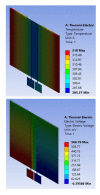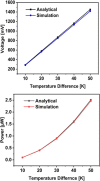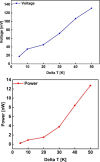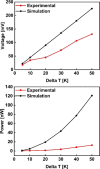Development of low-cost micro-fabrication procedures for planar micro-thermoelectric generators based on thin-film technology for energy harvesting applications
- PMID: 38990867
- PMCID: PMC11239049
- DOI: 10.1371/journal.pone.0306540
Development of low-cost micro-fabrication procedures for planar micro-thermoelectric generators based on thin-film technology for energy harvesting applications
Abstract
With the rapid proliferation of portable and wearable electronics, energy autonomy through efficient energy harvesting has become paramount. Thermoelectric generators (TEGs) stand out as promising candidates due to their silent operation, high reliability, and maintenance-free nature. This paper presents the design, fabrication, and analysis of a micro-scale TEG for powering such devices. A planar configuration was employed for its inherent miniaturization advantages. Finite element analysis using ANSYS reveals that a double-layer device under a 50 K temperature gradient generates an impressive open-circuit voltage of 1417 mV and a power output of 2.4 μW, significantly exceeding its single-layer counterpart (226 mV, 0.12 μW). Validation against the analytical model results yields errors within 2.44% and 2.03% for voltage and power, respectively. Furthermore, a single-layer prototype fabricated using paper shadow masks and sputtering deposition exhibits a voltage of 131 mV for a 50 K temperature difference, thus confirming the feasibility of the proposed design. This work establishes a foundation for developing highly efficient micro-TEGs for powering next-generation portable and wearable electronics.
Copyright: © 2024 Abdelkader et al. This is an open access article distributed under the terms of the Creative Commons Attribution License, which permits unrestricted use, distribution, and reproduction in any medium, provided the original author and source are credited.
Conflict of interest statement
The authors have declared that no competing interests exist.
Figures














References
-
- Jaziri N., Boughamoura A., Müller J., Mezghani B., Tounsi F., and Ismail M., “A comprehensive review of Thermoelectric Generators: Technologies and common applications,” Energy Reports, vol. 6. Elsevier Ltd, pp. 264–287, Dec. 01, 2020. doi: 10.1016/j.egyr.2019.12.011 - DOI
-
- Nozariasbmarz A. et al., “Review of wearable thermoelectric energy harvesting: From body temperature to electronic systems,” Applied Energy, vol. 258. Elsevier Ltd, Jan. 15, 2020. doi: 10.1016/j.apenergy.2019.114069 - DOI
-
- Jaziri N. et al., “Low-temperature co-fired ceramic-based thermoelectric generator with cylindrical grooves for harvesting waste heat from power circuits,” Appl Therm Eng, vol. 184, Feb. 2021, doi: 10.1016/j.applthermaleng.2020.116367 - DOI
-
- Dhanvijay M. M. and Patil S. C., “Internet of Things: A survey of enabling technologies in healthcare and its applications,” Computer Networks, vol. 153. Elsevier B.V., pp. 113–131, Apr. 22, 2019. doi: 10.1016/j.comnet.2019.03.006 - DOI
MeSH terms
LinkOut - more resources
Full Text Sources

